The Athlon II X2 & Phenom II X2: 45nm Dual-Core from AMD
by Anand Lal Shimpi on June 2, 2009 12:00 AM EST- Posted in
- CPUs
Adobe Photoshop CS4 Performance
To measure performance under Photoshop CS4 we turn to the Retouch Artists’ Speed Test. The test does basic photo editing; there are a couple of color space conversions, many layer creations, color curve adjustment, image and canvas size adjustment, unsharp mask, and finally a gaussian blur performed on the entire image.
The whole process is timed and thanks to the use of Intel's X25-M SSD as our test bed hard drive, performance is far more predictable than back when we used to test on mechanical disks.
Time is reported in seconds and the lower numbers mean better performance. The test is multithreaded and can hit all four cores in a quad-core machine.
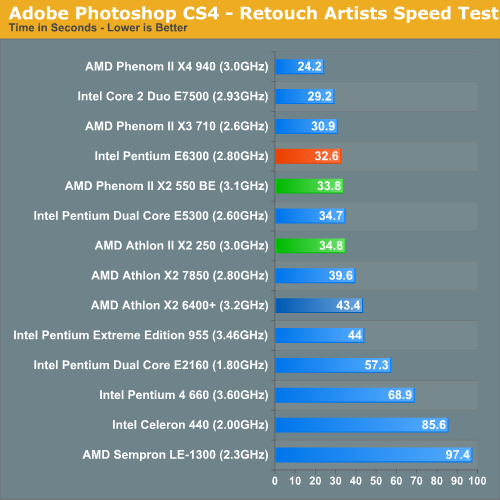
The Pentium E6300 pulls ahead in our CS4 benchmark; it's faster than both the Phenom II 550 and the Athlon II 250. Note the significant increase in performance from the Athlon X2 7850 to the Athlon II X2 250. All of the benefits of the Phenom II architecture are wrapped into the new Athlon II.
DivX 8.5.3 with Xmpeg 5.0.3
Our DivX test is the same DivX / XMpeg 5.03 test we've run for the past few years now, the 1080p source file is encoded using the unconstrained DivX profile, quality/performance is set balanced at 5 and enhanced multithreading is enabled:
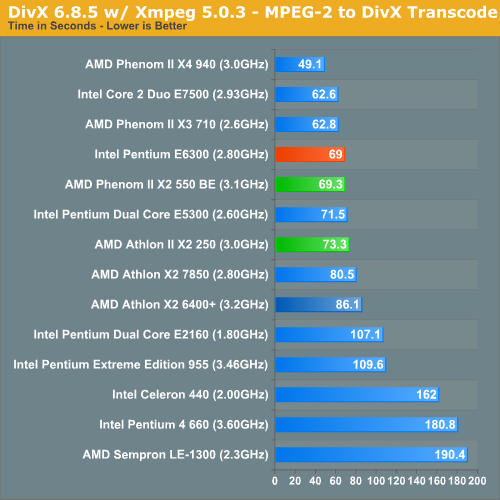
DivX performance is very close between all three contenders. The E6300 and Phenom II 550 are virtually tied while the Athlon II 250 isn't far behind. For faster performance in encoding you need more cores though.
The Pentium EE 955, at one time an encoding monster, is now as fast as a Pentium E2160 in our DivX test.
x264 HD Video Encoding Performance
Graysky's x264 HD test uses the publicly available x264 codec (open source alternative to H.264) to encode a 4Mbps 720p MPEG-2 source. The focus here is on quality rather than speed, thus the benchmark uses a 2-pass encode and reports the average frame rate in each pass.
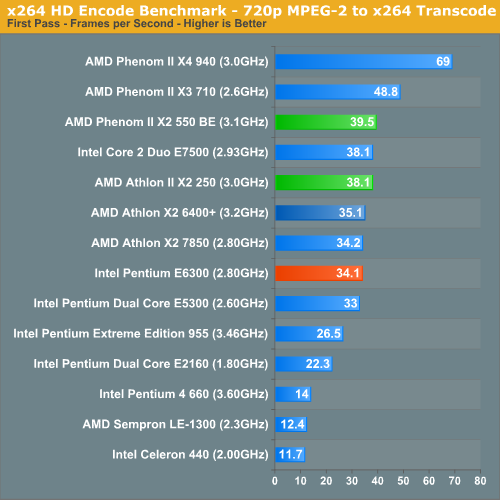
The latest version of the x264 codec fixes the problem exemplified in our first pass results, but these are still interesting to look at. Because of a number of unaligned memory loads all of Intel's pre-Nehalem Core based processors are penalized. The result is both the Athlon II and Phenom II are ahead of the E6300 here.
In the second pass of the test however, things return to "normal". The E6300 is technically in between the two new AMD dual-core chips, but all three basically perform the same. The Phenom II X3 710 adds another 40% to the processor cost and yields an extra ~20% in performance.
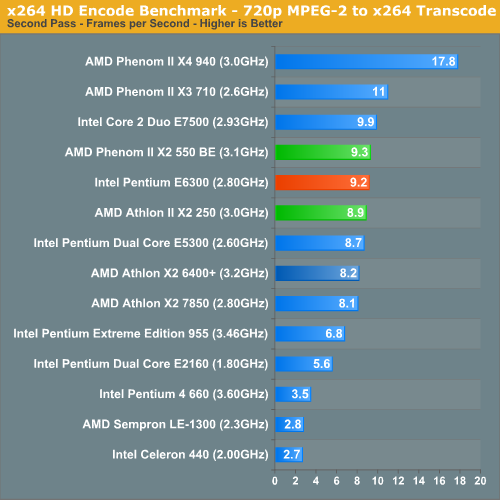
Windows Media Encoder 9 x64 Advanced Profile
In order to be codec agnostic we've got a Windows Media Encoder benchmark looking at the same sort of thing we've been doing in the DivX and x264 tests, but using WME instead.
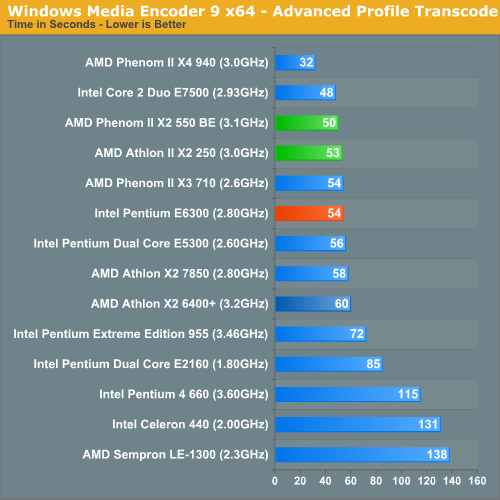
Under WME, both of the AMD chips are a bit faster than the E6300. Note that even the triple-core Phenom II 710 is slower than the Phenom II X2 550; not all applications work well with AMD's odd 3-core configuration.










55 Comments
View All Comments
adiposity - Friday, June 5, 2009 - link
10 minutes is wrong, it's more like an hour for sub-src. My mistake.adiposity - Wednesday, June 3, 2009 - link
Oh, andconfigure -release
Will build only release target, speeds things up as well.
adiposity - Wednesday, June 3, 2009 - link
make thatconfigure -release -no-webkit
ssj4Gogeta - Tuesday, June 2, 2009 - link
Anand, the x264 first pass encoding graph is "higher is better" but the processors are arranged with the shortest bar (slowest processor) on the top. Please fix that.Ryan Smith - Tuesday, June 2, 2009 - link
Noted and fixed.